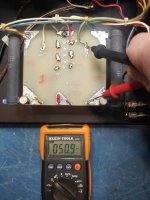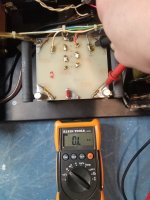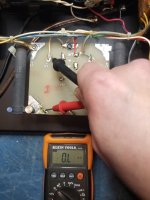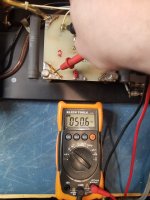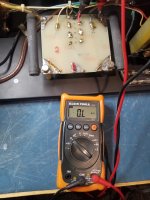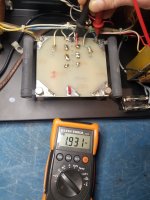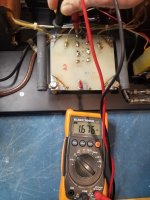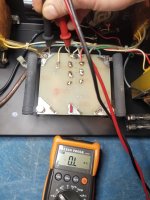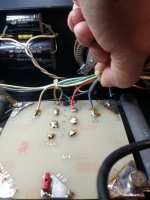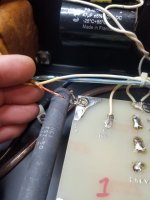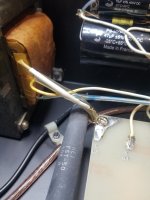I rebuilt the high voltage power supplies. I moved the interfaces to the opposite panel they were hooked to originally when I picked them up. They dont sound any different. One is much louder then the other. The issue is moving with the interface not the pannel. I did measure voltage with my killavolt meter. Both read the same at 1200v but at such a small amperage I'm guessing my meter is not accurate. Idk what else to replace besides the 500m resistor. Is it common for the transformers to fail in this way? I have only had them powered up for about a half hour so I figured they might take a bit to charge up but the output difference has me wondering if somthing is a miss. The one is easily twice the db of the other. I did measure the 750v with a regular dmm from the hv transformer and the voltage is there. If anyone has any advice I'd appreciate it.
Since the issue moves with the interface, we can rule out any problems with the panels.
If you measure equal voltages after the 500 Mohm resistor, (at the red output jack) then I would say your bias supply is functioning properly. It's normal to measure less than the actual voltage due to loading effects. If the voltages are equal before the 500 Mohm resistor, but not after, then the 500 Mohm is suspect.
Otherwise, it's time to turn your attention to the audio portion. The fact that you are getting some sound from the speaker would tend to rule out any issues with the primary circuits feeding the audio transformers. So I would begin by checking the 50 kohm resistors and .01 uF capacitors in the secondary circuit. Lift one end of each capacitor, and check then both capacitors and resistors for open or shorted conditions.
If those check out okay, you may have an issue with one of the audio transformers. Other than checking for open windings with an ohmmeter, any further analysis of the transformers will require more test equipment. Do you have access to a signal generator and meter capable of measuring audio frequencies?
Any tests described above (other than measuring bias voltage) should be done with AC power removed and residual voltage discharged, and the speaker disconnected.
If you measure equal voltages after the 500 Mohm resistor, (at the red output jack) then I would say your bias supply is functioning properly. It's normal to measure less than the actual voltage due to loading effects. If the voltages are equal before the 500 Mohm resistor, but not after, then the 500 Mohm is suspect.
Otherwise, it's time to turn your attention to the audio portion. The fact that you are getting some sound from the speaker would tend to rule out any issues with the primary circuits feeding the audio transformers. So I would begin by checking the 50 kohm resistors and .01 uF capacitors in the secondary circuit. Lift one end of each capacitor, and check then both capacitors and resistors for open or shorted conditions.
If those check out okay, you may have an issue with one of the audio transformers. Other than checking for open windings with an ohmmeter, any further analysis of the transformers will require more test equipment. Do you have access to a signal generator and meter capable of measuring audio frequencies?
Any tests described above (other than measuring bias voltage) should be done with AC power removed and residual voltage discharged, and the speaker disconnected.
I do have a scope and signal generator. I am a seasoned tech but not with these at all. I homed out the big 50k resistors and they all read about spot on. I did search the troubleshooting and didnt come up with anything. I did find a bunch of posts but most of them are the spectra series. I removed the interfaced and just probed around a bit looking for discrepancies between the two interfaces. The only difference I found was when checking resistance across the big capacitor. I will post pics of this instead of trying to explain it. Idk if this is helpful. Notice the boards are labeled 1 and 2 with a red marker.
Attachments
Also measures strange here. Again I'm not sure if this is helpful one bit. I'm still learning how these things work. I would imagine with everything being identical these readings should be similar. When in fact they are opposite from one interface to the other.
Attachments
To me it seemed like on interface has a bad low frequency transformer and one has a bad high frequency transformer. As I was looking around in the one with the bad low frequency transformer I noticed this wire was broken from low frequency transformer. It looked like it was in place while it was sitting right against the pad that it was soldered too. Well I soldered that up and now the one speaker sounds great. It has great high frequency extension as well as great bass. I'm going to see if I can test the high frequency transformer in the other interface. The one I have running sounds excellent.
Attachments
So the interface that still isnt working correctly is ok n my bench. I'm running a sine wave in and probing around. Where the wire from the low frequency transformer runs onto the pcb with the soldered down eyelet there is a poor connection. The wave isnt even half as big as the other wire coming from the xformer. So I cut it off and stripped the insulation and cleaned off the coating on the copper I'm getting the full size wave. I'm going to solder some wire on to extend it a bit and solder it down and hope that takes care of my issue. I swear this pannel seemed to be missing more of the high frequencies also but il see soon enough . Seems like a strange failure point. But I guess if when assembled the coating off the copper wasnt removed well I guess some oxidization could have built after all these years.
Attachments
I may have spoke a little bit too soon. One pannel has a little arcing. It is very hard to hear it. I have to listen real closely to hear it. So is vacuming the trick to taking care of that? It is very minor and I'd imagine most people wouldn't hear it unless I pointed it out. Also about how much power do these need? I didnt think they were as difficult to run as planer speakers. I'm running them with a audio research d-110b. It does run them pretty good but when I crank it up i can tell the arc is working pretty hard by looking at the meters. The audio research runs my polk audio sda srs (wich aren't super efficient themselves) to ear bleeding volume effortlessly. So I am kind of surprised it doesn't run these easier. I guess il leave these plugged in for a bit and see if they get easier to run after I let them drain and vacume them if that is the plan.
Thanks for your continued help. I’m out of my depth with electronics and appreciate any help.That appears to be an MK-121 B or C enclosure, and you do NOT want to remove any of the screws on the top of the enclosure. Those are for attachment of internal parts.
You want to remove the screws on the sides of the chassis. This will allow removal of the L-shaped interface chassis. There are large screws inside the side plates (visible after removing the interface chassis) that attach the panel array to the side plates, and also the side plates to the base (the base-attachment screws generally do not need to be removed).
If you are having difficulty removing the screws, I suggest a small drop of your favorite penetrating oil (WD40 or similar) on the screw, and then it soak a while. A loss of volume is typically caused by a defective bias supply: rebuilding the bias supply is covered elsewhere in thus thread. Parts are cheap and generally readily available.
Is there anyone out there who rebuilds these transformers who you can recommend?
Glad to hear of your troubleshooting success. The issues you found nicely correspond with the difficulties you experienced.I may have spoke a little bit too soon. One pannel has a little arcing. It is very hard to hear it. I have to listen real closely to hear it. So is vacuming the trick to taking care of that? It is very minor and I'd imagine most people wouldn't hear it unless I pointed it out. Also about how much power do these need? I didnt think they were as difficult to run as planer speakers. I'm running them with a audio research d-110b. It does run them pretty good but when I crank it up i can tell the arc is working pretty hard by looking at the meters. The audio research runs my polk audio sda srs (wich aren't super efficient themselves) to ear bleeding volume effortlessly. So I am kind of surprised it doesn't run these easier. I guess il leave these plugged in for a bit and see if they get easier to run after I let them drain and vacume them if that is the plan.
The slight arcing you hear may clear up on its own, or, the vacuuming approach is always a good idea. Keep in mind that at some point, the panel will reach its dynamic limit, at which time the speaker will let you know with a ticking sound, especially on large bass notes. This doesn't harm the panel (unlike some brands of ESLs), but it lets you know it's time to turn down the volume a bit. Use of a subwoofer (with the panels rolled-off on the low end) will extend the speaker's dynamic capacity.
How much power you need is very subjective, and in some cases, amplifiers with similar wattage ratings will yield different results. This will depend on the amplifier's output impedance vs. frequency, and the amp's ability to drive low impedance, highly reactive loads. ESLs by their nature are difficult to drive and not terribly efficient. Note that ESLs are also considered planar speakers but differentiated from magnetic speakers. Planar magnetics can also be rather inefficient, and although they can have a low impedance, it's usually a mostly resistive load, and therefore easier to drive. Personally, for my musical tastes and my size of room, I'd strive for power in the range of 100-250 watts per channel. Many Acoustat owners are satisfied with less. More than 250 watts is unlikely to offer much advantage and has an increased chance of damaging the speaker.
I would live with the speaker/amp combo you have now and wait and see how things go. As the speaker fully charges (which can take several days) and "settles in" you may find your satisfaction increasing.
I believe Roy Esposito (former Acoustat employee, located in Florida) is still doing interface repairs. Try contacting Roy at acoustat.service.usa@gmail.comThanks for your continued help. I’m out of my depth with electronics and appreciate any help.
Is there anyone out there who rebuilds these transformers who you can recommend?
So the arcing did clear up on it's own. These speakers sound phenomenal. I have a bunch of amplifiers so I dug out my jbl urei 6290. Its 300wpc at 8ohm and 600wpc at 4ohm. This amp makes these model 3 sing effortlessly. The low end is amazing and much more of it then I anticipated. I've had many planer speakers and electrostatics. These hold there own for sure. Yes I had a couple strange issue specially that one wire from the transformer that somehow had a bad connection. I'm glad with normal troubleshooting I was easily able to find the issues.Glad to hear of your troubleshooting success. The issues you found nicely correspond with the difficulties you experienced.
The slight arcing you hear may clear up on its own, or, the vacuuming approach is always a good idea. Keep in mind that at some point, the panel will reach its dynamic limit, at which time the speaker will let you know with a ticking sound, especially on large bass notes. This doesn't harm the panel (unlike some brands of ESLs), but it lets you know it's time to turn down the volume a bit. Use of a subwoofer (with the panels rolled-off on the low end) will extend the speaker's dynamic capacity.
How much power you need is very subjective, and in some cases, amplifiers with similar wattage ratings will yield different results. This will depend on the amplifier's output impedance vs. frequency, and the amp's ability to drive low impedance, highly reactive loads. ESLs by their nature are difficult to drive and not terribly efficient. Note that ESLs are also considered planar speakers but differentiated from magnetic speakers. Planar magnetics can also be rather inefficient, and although they can have a low impedance, it's usually a mostly resistive load, and therefore easier to drive. Personally, for my musical tastes and my size of room, I'd strive for power in the range of 100-250 watts per channel. Many Acoustat owners are satisfied with less. More than 250 watts is unlikely to offer much advantage and has an increased chance of damaging the speaker.
I would live with the speaker/amp combo you have now and wait and see how things go. As the speaker fully charges (which can take several days) and "settles in" you may find your satisfaction increasing.
Do the foils of Acoustats age? I see a pair of 1+1 offered about two hours from my house, presumably in perfect working order, but I am a little sceptical as most other electrostats seem to need foil replacement every 10 - 15 years. Also, are the foils replaceable at all? I saw a post by AnswerMan that the panels cannot be opened withour breaking them.
Bonus question: are there any harmonic distortion measurements out there? I wonder if they are as low as the ESL 63.
Bonus question: are there any harmonic distortion measurements out there? I wonder if they are as low as the ESL 63.
The use of the term "foil" suggests a metalized diaphragm, which ESLs do not have. ESLs use a high-resistance, conductive coating applied to a plastic membrane, usually Mylar (a DuPont brand name) or similar material. A big difference between different brands of ESLs is the composition of that conductive coating, how it is applied, and its longevity.
Acoustat panels use a carbon-black based proprietary material that actually creates a solvent bond to the plastic diaphragm. There has been the occasional report of this coating flaking off, or cracking, but this is NOT an inherent problem, and is probably due to variations in workmanship. The point being is that one does not generally need to be concerned about this failure mode, unlike some other brands of ESLs, which DO suffer from periodic coating or diaphragm failure. Acoustat panels are not considered to be repairable. Sometimes the diaphragm can lose its tension, but being a heat-shrinkable material, that is easy to fix without disassembly of the panel.
I am not aware of any distortion measurements. Very few speaker manufacturer measure distortion, much less publish any specifications. But I would certainly expect any ESL to exhibit similar harmonic distortion, likely to be far less than other speaker types.
Acoustat panels use a carbon-black based proprietary material that actually creates a solvent bond to the plastic diaphragm. There has been the occasional report of this coating flaking off, or cracking, but this is NOT an inherent problem, and is probably due to variations in workmanship. The point being is that one does not generally need to be concerned about this failure mode, unlike some other brands of ESLs, which DO suffer from periodic coating or diaphragm failure. Acoustat panels are not considered to be repairable. Sometimes the diaphragm can lose its tension, but being a heat-shrinkable material, that is easy to fix without disassembly of the panel.
I am not aware of any distortion measurements. Very few speaker manufacturer measure distortion, much less publish any specifications. But I would certainly expect any ESL to exhibit similar harmonic distortion, likely to be far less than other speaker types.
- Home
- Loudspeakers
- Planars & Exotics
- Acoustat Answer Man is here
